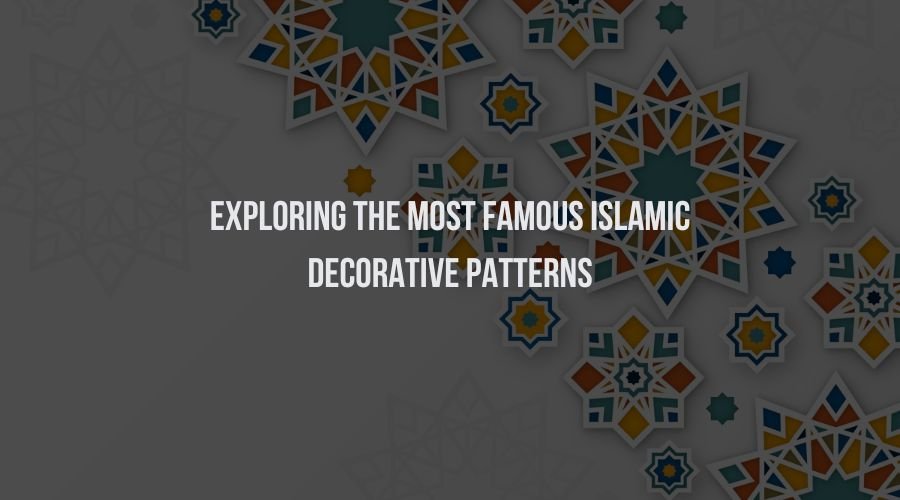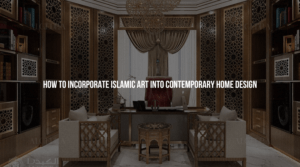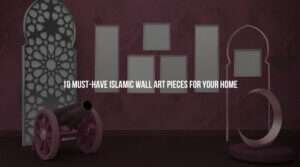Islamic art has a rich history spanning over a millennium, transcending geographical boundaries and encompassing a diverse array of genres and forms, from the Taj Mahal to the most exquisite specimens of silk Persian rugs. These days, all forms of art produced in regions where Islam predominates are included in the category of Islamic art for muslim home decor. These comprise, among other nations, Iran, Egypt, India, Morocco, Spain, Syria, and Turkey. Islamic art encompasses all forms of art produced within the Islamic world and is not limited to religious art.
Islamic artists, in contrast to what we frequently see in Christian or Jewish art, are inclined to adhere to the idea of aniconism, which is the conviction that God created living things, including people, and that this fact ought not to be represented in works of art. The ban on idolatry—worshipping an object or image in place of God—has an impact on Islamic aniconism.
Thus, we see common Islamic art patterns, designs, and motifs in place of human or animal images in traditional Islamic art (aside from secular Islamic art). Islamic pottery, Islamic wall art, and Islamic canvas art are intricate and colourful pieces that frequently feature geometric and abstract patterns, recurring calligraphy, and depictions of plants or flora.
We will examine some of the most significant aspects of Islamic art, their influences, and give a general summary of particular pieces that are sought after by collectors and their current market value, even though it is impossible to cover the entire scope of Islamic art, which dates back to the 7th century, in a single article.
Islamic Art Features
Three essential elements of Islamic visual art are calligraphy, geometric patterns, and floral themes. These components, which frequently cross over into many genres and art forms, are inspired by Qur’anic ideas.
Floral Designs and the "Arabesque"
Islamic artists used floral motifs for human or animal shapes in their works due to their belief in Islamic aniconism. These floral themes, which can be seen in Islamic ceramics, carpets, tiles, and other materials, steer clear of realistic ideas like development or life. There are theological connotations associated with some flower or plant species; the cypress, for instance, is frequently associated with humility before God.
Four- or five-petalled flowers are commonly seen in Timurid texts, Ottoman tiles, Safavid carpets, and other works, according to the Museum of Islamic Art Doha. We also see what is known as arabesque, or interlacing, rhythmic, and scrolling floral patterns, in many forms of Islamic artworks such as these.
On items and structures, arabesque surface decoration (Muslim Home Decor) gained widespread popularity, and further plant-based motifs continued to produce intricate, scrolling patterns. The V&A Museum states that “grids, reflective and rotational symmetry, and freehand design” were methods used by Islamic artists to achieve floral patterns and motifs.
Islamic Calligraphy Art
Perhaps the most direct connection between Islamic art (islamic wall art) and the Qur’an was found in calligraphy. Islamic calligraphy art quotes passages from the Qur’an, or Allah’s (God’s) message, and is found on metalwork, pottery, and the walls of significant buildings. Poetry scripts are, therefore, common in Islamic art (islamic wall art)and architecture, emphasising the significance of the Arabic text of the Qur’an (but Ottoman and Persian languages are also included in Islamic calligraphy art). Again, Islamic calligraphers might commemorate and worship Allah through calligraphy without resorting to idolatry by not portraying him as a live entity.
Islamic calligraphers traditionally utilise the qalam, a pen composed of dried bamboo or reed. Other methods use pens with metallic tips. Calligraphy can be done on a variety of surfaces, such as paper, tiles, vases, carpets, and stone, and is frequently done in vibrant ink colours.
Islamic Geometric Art
The geometric element in Islamic art (islamic wall art) is the last but most important component. Intricate patterns are created by combining squares and circles on a variety of surfaces, including ceramics, jewellery, paper, metal, glass, and wood, as well as pottery, carpets, and tiles. They frequently appear to overlay calligraphy and floral themes or possibly to provide the framework for them.
Since the ninth century, geometric patterns with stars and lozenges have been used. Nonetheless, 6- and 13-point star patterns appeared in the thirteenth century. Artists later created increasingly intricate patterns with 14- and 16-point stars in the 16th century.
Because they reduced attention to figural things and encouraged spiritual reflection due to their complexity, geometric designs were also popular because they adhered to Islamic aniconism. These continuous, looping, and scrolling forms simultaneously conveyed a sense of divine unity and oneness with God’s limitless creations.
Islamic art (islamic wall art) encompasses a wide variety of shapes and media, such as wall tapestries, paintings, ceramics and stained glass, tile work, carpets, metal constructions, timber furnishings, and more. The Persianate world was dominated by wall paintings and manuscripts; Berbers, Persians, and Armenians, to name a few, produced superb rugs, and vast buildings with features characteristic of Islamic architecture towered over parts of southern Spain, India, Turkey, and Iran. Regarding Islamic ceramics, the earliest industrial complex for the manufacturing of glass and pottery was located in Syria around the eighth century. Islamic art’s development has been greatly influenced by new cultures, wars, invasions, and customs that have arisen in Europe, the Middle East, and Asia.




